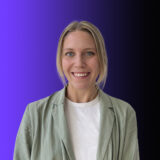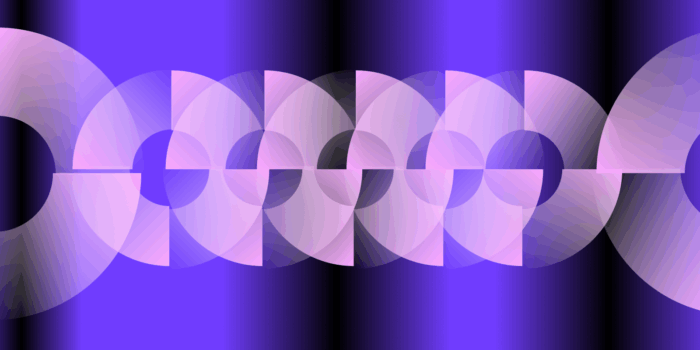Branding and branded creative are everywhere. From the tops of our hats and the bottoms of our water bottles to the reverse side of the screen that we’re all reading this on (our’s has a fruit on it), logos, labels, and brands are all around us and they’re vying for attention.
Marketing today is more competitive than ever before and thus, branding has taken center stage. More specifically, performance branding and performance creative have become significant and essential tools for achieving growth and success for businesses.
Definitions of Performance Branding & Performance Creative
Performance branding is the true hybridization of two schools of thought: it leverages a data-first lens and layers it on top of traditional brand thinking.
Unlike traditional branding, which focuses on building brand awareness and perception, performance branding uses data-driven metrics to measure the impact of branding efforts on key business metrics such as sales and customer acquisition.
Performance creative is the offspring of that. The creative produced as a result balances both long-term brand building and immediate marketing goals by applying metrics like ad recall and engagement rates to drive creativity that produces conversations and maximizes revenue potential. Focusing on performance creative is crucial for finding success in digital marketing.
In this article, we’ll dive into the importance of performance creative and give you tips on how you can optimize your performance creative throughout every stage of the buying funnel.
Why is Performance Branding Relevant to Marketing Today?
It’s widely known that first impressions are everything, and that couldn’t be more true in digital marketing. There’s no doubt that the average person’s attention span is declining, so whether it’s scrolling or swiping, brands have a narrow window to hit when aiming to capitalize on audience attention.
That’s where data comes in. By using performance, analytics, and past learnings, businesses are able to be more strategic and methodical when producing creatives to hit ever-growing narrow targets. Performance creative allows brands to evaluate and make informed decisions, mitigating the guesswork involved with the effectiveness of creatives and brand campaigns. Creative can, therefore, not only hit branding and marketing goals with precision but also be able to hit them repeatedly.
Metrics to focus on to determine the success of your performance creative:
- Hook rate: (3-Second Video Plays/Impressions)×100
- Hold rate: (50% Video Plays/Impressions)x100
- CTR: (Clicks/Impressions)x100
- CPA: (Cost/Conversion)x100
- ROAS: (Revenue/Cost)x100
Performance Creative: As Seen Through The Funnel

A great way to understand and employ brand creative in a performance capacity is by connecting stages of the funnel with audience intent.
Prospecting & Cold Audiences
Audiences at this stage are in the discovery phase for a given brand. They’re window-shopping. Their purchasing intentions are low.
Creatives produced for this stage should prioritize a wow-factor. Brands should pull out all the visual stops here. Think vibrant eye-catching use of brand colors, clear and visible logos, and succinct headlines (and even quip!).
At this stage in the funnel, you shouldn’t just be capturing the attention of your audience, but also informing them on who your brand is and what sets you apart from your competitors. Generate brand awareness. Focus on content that’s authentic, tells a story, provides brand or product education, and/or appeals to communities relevant to your target audience.
For example, you could build creative that tells the brand’s origin story, why your version of a product is necessary, or why specific group(s) are important and meaningful to the brand.
Content-wise, video that incorporates or features people and/or dynamic motion graphics has proven to be the most effective here. Video offers the richest visual engagement and is usually most effective at grabbing attention. It can easily break our subconscious flow and monotony of scrolling. (After all, evolution dictates that our eyes are programmed and attracted to motion thanks to the survival needs we picked up in our primitive days!)
Focus on your hook and hold rates for videos to determine what’s capturing your audience’s attention the most.
- Hook Rate: 3-second video plays/impressions
- Hold Rate: ThruPlays/3-second video plays
Consideration & Warm Audiences
Here, audiences know and recognize their brands of interest. They’re jotting out their pros and cons lists with their purchase intent contingent on which brand makes the most sense for them.
At this stage, brands should really lean into substance with their creative. Headlines should be in lock-step with subheadings as the priority shifts to communicating feature statements.
Compositionally, you should lean more toward clarity than vibrancy. Visual pop and clear space are not mutually exclusive, but erring on the side of caution with your design can help make sure you’ve optimized your copy and preserved readability to really draw your audience in.
Creative should double-down on brand education and engagement. Content that speaks to the product’s unique experience and benefits is a key player here. For example, your creative could showcase before and after results, highlight key differentiators with a top competitor, or present a well-known problem and position your product as the best solution.
Content-wise, all creative formats are effective, but we find that static and traditional gifs are at highlighting benefits clearly and concisely, without some of the additional fluff you might find in a video.
When it comes to video, UGC is both king and queen. The power of UCG goes beyond a person speaking directly to the product benefits. UCG enables other audience members at this stage of the funnel to visualize and project themselves into the experience of what it would be like to have the brand’s product as well as see the members of a community they may align with or aspire to be, thus bringing them closer to conversion.
Activation & Hot Audiences
Audiences here have high purchase intent and are prepared to spend. They just need the final push, and your performance creative can help them get there.
Nearing the finish line, the creative here needs to spur action. Brands should be directive in their approach to both visual components and copy. Explicit Calls-to-Action (CTAs) are crucial and take center stage. Buttons, arrows, and/or links should be made obvious through compelling accent colors, size, and scale of copy, and when possible, aided by motion. Copy-wise, the fewer words here, the better.
Creative needs to target conversion as its singular focus. Content that appeals to a range of potential audience emotions stands out here. For example, your creative could center the idea of the purchase around a fear of missing out or a limited time promotion, or it could highlight genuine, positive reviews (or other forms of social proof) to address any last-minute doubts.
Content-wise, video and motion make a return to help “stop the scroll.” When compared to the prospecting stage, however, moving elements should be somewhat more subdued. Creatives need to leverage visual engagement without being overly superfluous and drive attention to the CTA.
Retention & Existing Audiences
Arriving at the bottom, audiences at this stage have already converted and are bought in. That said, performance creative still matters to ensure they don’t spill out of the funnel.
Creative at the retention stage cannot ignore creative strategy that was implemented at earlier stages in the funnel. Content should continue to explore ways to bring the brand closer to its community within the avenues of proven creative success. If the creative ain’t broke, don’t fix it; just iterate.
For example, if storytelling is really winning with audiences, explore new hooks to grab attention. If product presentations are delivering results, explore ways to add to and refine the existing art direction.
As such, all creative formats are effective here content-wise. The most important nuance is delivering creative that reinforces the community and expands upon the brand story and beloved values.
The Bottom Line of Performance Creative
Performance Creative Doesn’t Make the Creative Any Less Creative
Effective design has always been a delicate balance between form and function. Performance creative and audience intent only serve to inform the edges of the canvas. No matter where in the funnel, or whatever your goal is, there are always going to be new ways to test and implement new creative designs and strategies without losing the creative direction of your brand.
Performance Is Your Creative Director
The ability to ascribe quantifiable metrics and track the performance of creative content types and/or campaigns provides visibility into what can be scaled, taken to the next level, and where those opportunities lie within the creative itself. Conversely, with metrics that trend downward, you can gain insights into areas where it may be time to change things up and pivot, saving time and resources. Up or down, clear direction is always readily available.
It’s Okay to Deviate
What works in digital marketing is in constant flux, so best practices are only as relevant as they are today. Allow data to set the scene for new tests that push creative boundaries as performance creative is experimental and iterative by nature. After all, new trends are set by new breakthroughs.

Performance Creative & Branding: Final Thoughts
Performance branding and creative have become powerful tools within growth marketing. In the past, branding and related creative assets were rooted in more abstract concepts and less quantifiable insights, but with performance creative, businesses have greater agency and control over impactful assets.
Empowering creative with performance metrics, brands are able to take a more distilled approach throughout all stages of brand campaigns, ensuring the work resonates with the right folks at the right time. This targeted approach to brand creative also allows brands to scale and drive conversion repeatedly as growth is supported by creative consistency and compounded learnings.
So if hat, water bottle, and device brands are all taking their best brand marketing shots in the dark, then operating under the guise of performance creative is doing so with the 20x, night vision scope with digital display. If we had to pick, we’d choose the latter.






